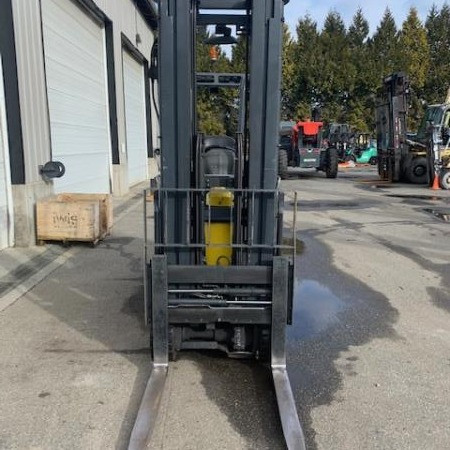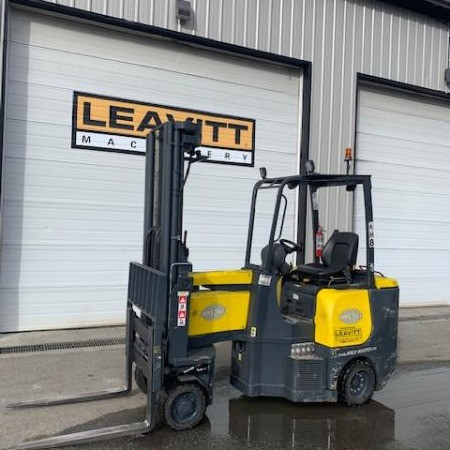Very Narrow Aisle Forklift Ventura
Used Very Narrow Aisle Forklift Ventura - Getting items from one warehouse location to another and to and from the loading docks is the focus of warehousing. Focus is often on space saving tools and the layout of the building. Very narrow aisle solutions allow for more space to be dedicated to the storage of goods because less space is required for aisle access. These warehouse configurations are often referred to as warehouse optimization.
Warehouse Optimization
Several benefits can be enjoyed for adding very narrow aisle warehouse optimization such as more storage space for the facility.
Because very narrow forklift trucks were developed to take up less space in maneuvering, it is now possible to decrease warehouse aisle width to less than half the width required by standard forklifts. Certain models of very narrow aisle forklifts can increase the square foot storage capabilities by delivering greater stacking heights. Very narrow aisle forklifts can greatly reduce costs compared to traditional forklifts since the same amount of stock takes up less space in the warehouse. In most urban areas where square footage is very costly, this is a huge benefit to warehouse operations. When planned carefully and properly, it is possible to increase warehouse storage area by up to 80 percent by implementing a very narrow aisle width configuration. This warehouse design creates more rack faces and increased product access. Reduced travel time for storing items and gathering products are some of the key benefits to this warehouse layout as more products are found in an accessible location.
It is common for warehouses to use a very narrow or narrow aisle layout. Less than eleven feet of aisle width is needed by narrow aisles. Very narrow aisles usually use an aisle width of approximately 6.5 feet across. Either of these widths drastically increases storage potential. However, they also create challenges when turning within the aisles using forklifts for stocking and order picking. A variety of very narrow forklifts have been designed to easily maneuver in narrow aisles.
When selecting a forklift for a job application, it is essential to know the aisle dimensions. Having the right aisle dimensions will save money and time instead of purchasing the wrong forklift that won’t be able to conquer the applications. It is essential to take any columns, posts or utilities into account before deciding a type of narrow aisle forklift design as these can block access.
Very Narrow Aisle Forklift Trucks
Very narrow aisle forklift trucks are almost always powered electrically, usually by rechargeable battery. These very narrow aisle trucks are more commonly available as stand-up riders, which helps increase productivity and operator comfort. There are different very narrow aisle forklift designs such as order pickers, reach trucks, wing-mast or turret and end-control riders.
Reach Forklift Trucks
Reach trucks were designed as a version of the rider stacker forklift but specially modified for use in narrow aisles. The reach trucks developed their name from their forward-reaching actions to get a load. The two kinds of reach trucks the moving carriage and the moving mast. The moving carriage functions by lowering and raising the carriage and the operator. The moving mast raises and lowers the forks as the operator remains at ground level. Of the two kinds of reach trucks, the moving mast reach truck is the safer of the two varieties. These machines rely on a kind of jointed framework known as a pantograph system that enables the operator to place a load or reach the load without moving the machine.
Order Pickers
Order pickers have been designed and developed specifically for use in picking orders from high, typically hard-to-reach racks. These machines are used for picking up lighter stock that can be moved by hand. They lift the operator up to reach the goods by identifying and choosing certain items to create an order.
End-Control Riders
End-control riders are used to pick loads located at floor level and transport the load horizontally, rather than lift or lower loads from various heights.
Turret or Swing-Mast Forklift
Swing-mast or turret very narrow aisle forklifts feature an articulating swivel mast that pivots. The mast swivels to enable pallets to be positioned on the right or left side of the forklift.
Guided Very Narrow Aisle Trucks
Rail or wire can guide the very narrow aisle forklift trucks down the aisle securely.
Since the forklift truck is guided, the chance of colliding with racks while traversing down the aisles is very low. For rail-guided systems, a series of rails are installed into the floor, on both sides of the aisle, and run along the floor for the length of the aisle, curving around the end of the aisle. Wheel guides on the forklift slide into the floor rails to stop the machine from traveling out of bounds.
Wire-guidance forklift systems install wires on the floor instead of rails and the wires run down the middle of the aisle. Narrow aisle forklifts rely on a wire-guide system to help it communicate with the floor wires. This allows the machine to be steered by the wires, stopping it from traveling outside of the specific location.
Work Site Considerations
To use a narrow aisle configuration, there are some key considerations that need to be made. The narrow aisle units feature tall racking systems. The floor construction and the racks need to be carefully taken into account for everyone’s safety. There are four areas which must be meticulously prepared before setting up a racking system and must be continuously monitored and maintained throughout the operation of the warehousing system:
1. The floor must be level;
2. Cracks must be repaired;
3. Load capacity of floor must be appropriate; and
4. The racks must be plumb.
Level Floor
Due to the racking system height, any minor floor slope can gravely impact how plumb the racks are, particularly over time if loads are placed and removed repeatedly on the racks. The height of the racking system means that any minute floor slope can have a negative impact on how straight the racks are, especially over time when loads are continually removed and placed on the racks. Without a level floor foundation, the rack stability could be compromised.
Crack Repair
When cracks in the floor are spotted, they should be assessed and, when necessary, repaired immediately. Cracks may affect the floor’s level and, when they are approximately 3/8 inches wide, will need to be properly filled with a material at least as hard as the surrounding floor.
Floor Load Capacity
The floor needs to meet specific minimum requirements prior to a narrow aisle configuration. Minimum flooring requirements include concrete measuring three thousand psi and rebar distributed evenly three to four inches below the surface. Depending on the load requirements and configuration, additional reinforcements may be needed.
Plumb Racks
Installing the racks safely and correctly is vital for the entire system. If installed improperly, there is a great chance of rack failure. One of the most important details to ensure proper installation, is that all racks are plumb. Rack shims can help the rack stay plumb to one inch at the height of thirty feet.
If the above measures are not taken or are improperly implemented, it is likely to cause a racking failure. Such failure is likely to result in costly damage to goods, the warehouse facility, forklifts and, worst of all, employees could be significantly injured or even killed. Due to these potential problems, the most significant part of creating a narrow aisle configuration for warehousing optimization is the initial measurements.
Very Narrow Aisle Forklift PDF
Stock Number: 209213 GL
Make: AISLEMASTER
Model: 44SE
Year: 2015
| Stock Number |
209213 GL |
| Make |
AISLEMASTER |
| Model |
44SE |
| Year |
2015 |
| Category |
Very Narrow Aisle Forklift |
Stock Number: 207213 GL
Make: AISLEMASTER
Model: 44E
Year: 2013
| Stock Number |
207213 GL |
| Make |
AISLEMASTER |
| Model |
44E |
| Year |
2013 |
| Category |
Very Narrow Aisle Forklift |
Stock Number: 208758 GL
Make: AISLEMASTER
Model: 44SE
Year: 2015
| Stock Number |
208758 GL |
| Make |
AISLEMASTER |
| Model |
44SE |
| Year |
2015 |
| Category |
Very Narrow Aisle Forklift |













